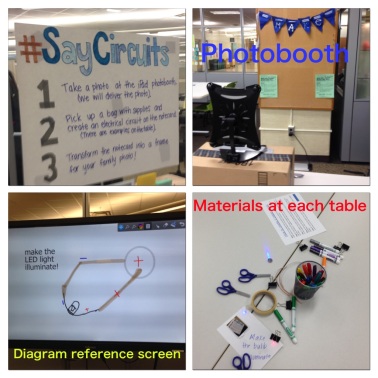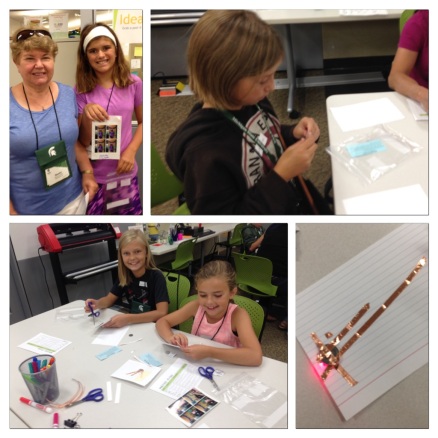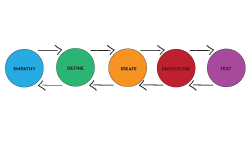You are all designers:
You will design and host a Maker Faire.
This was an assignment presented to my Master of Arts in Education Technology (MAET) class just last week.
We had very little understanding of what a Maker Faire was, or meant. We instantly began to question this assignment, because it was not clear enough for us.
Using the Design Thinking Process, my MAET colleagues and myself, successfully pulled off a Maker Faire in less than one week! I am still in shock, because we started from scratch.
The Maker Movement, “generally refers to using a wide variety of hands-on activities (such as building, computer programming, and sewing) to support academic learning and the development of a mindset that values playfulness and experimentation, growth and iteration, and collaboration and community,” (Herold, 2016).
“Part science fair, part county fair, and part something entirely new,” Maker Faire is an event for all ages that allows thinkers and tinkerers to explore and question various experiences (Maker Faire – A Bit of History, 2004). This is true, as I found out first hand.
The Maker Movement is very “in” right now, but there are aspects of this experience that must be considered when implementing a Makerspace or Maker Faire.
Even with reading and researching about the Maker Movement, the best way to learn is by “doing” (or in this case “making”). Although this process was done at a very fast pace, I broke down some of the basics of how we went about the process of designing a Maker Faire.
As you can probably tell from the Design Thinking and Planning of a Maker Faire, the area that required much of our focus was the Ideate step. The marketing plan, and need for collaboration was crucial! Fortunately, I was working with a very dedicated group of teachers who had the same value as I did. (#MAETy1) To understand what a Maker Faire means.
Collectively we created a logo, hashtags (#SpartansMake), flyers, and focused on how the Maker Space(s) would best fit each activity.
When working with my partner our planning was more focused on the maker experience. #SayCircuits was created based on the need to understand energy transfer within an electrical circuit, and smiling for a photo (say cheese!). We spent a lot of time creating a concrete plan and this part of the process allowed us to be successful when it came to the Maker Faire. (Click the graphic to read the details of our Maker Space #SayCircuits).
After a long week of hard work, questioning, and problem solving, the result was very moving.
I realized not only what a Maker Faire was, but how effective this concept is. Ultimately, “you don’t learn unless you question,” (Berger, 2014). In this case we were given a task to design/host a Maker Faire, and instantly the questions developed. With more than fifty questions to explore, we walked away feeling a sense of accomplishment and deeper understanding of the Maker Movement.
When participants came to #SayCircuits I noticed all of the participants, young and old, were engaged with the task at hand.

Similar to our experience with designing a Maker Faire, they needed to get the light to illuminate. The level of perseverance was what really impressed me about hosting our activity. Some of the participants would not give up on their task, even after 30 minutes. They were determined!

With careful planning, the Maker Movement will continue to allow all learners to question, explore, and ultimately “make” something (whether it is a product or a connection of new learning in their brains). I experienced this first hand, and I hope you can find an opportunity to attend a Maker Faire to get your feet wet!
When I think about taking this experience back to my classroom, I want to use the idea of creating a task (rather than a question) and allow my students to question and explore in their own way. “Fear is the enemy of curiosity,” and if I restrict my students from being curious they will not question, or explore new ideas on their own (Berger, 2014).
This is what the Maker Movement is all about!
Creating a safe environment, like a Maker Faire, to question and fail, will allow all of us to go north and continue pushing ourselves to our greatest potential.
If you want more information or have questions about our #SayCircuits activity from the Maker Faire, I would be happy to reply to any of your comments!
References:
Berger, W. (2014). A More Beautiful Question. New York: Bloomsbury.
Herold, B. (2016, April 11). The Maker Movement in K-12 Education: A Guide to Emerging Research. Education Week. Retrieved from http://blogs.edweek.org/edweek/DigitalEducation/2016/04/maker_movement_in_k-12_education_research.html?cmp=soc-tw-shr
Maker Faire – A Bit of History. (2004). In Maker Media Inc.. Retrieved June 30, 2016, from http://makerfaire.com/makerfairehistory/



